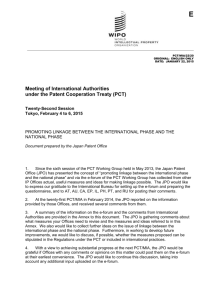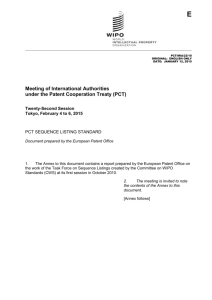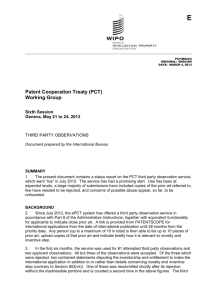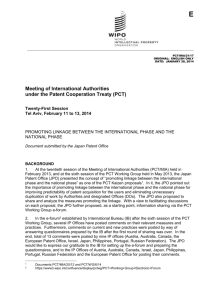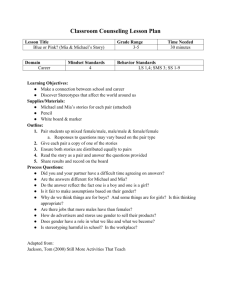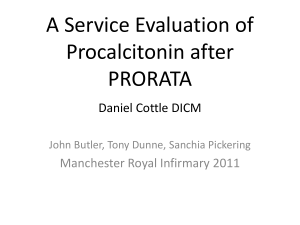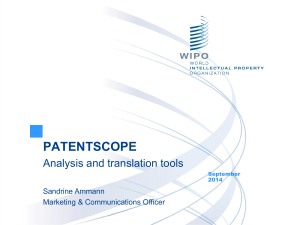Comments at PCT/MIA
advertisement
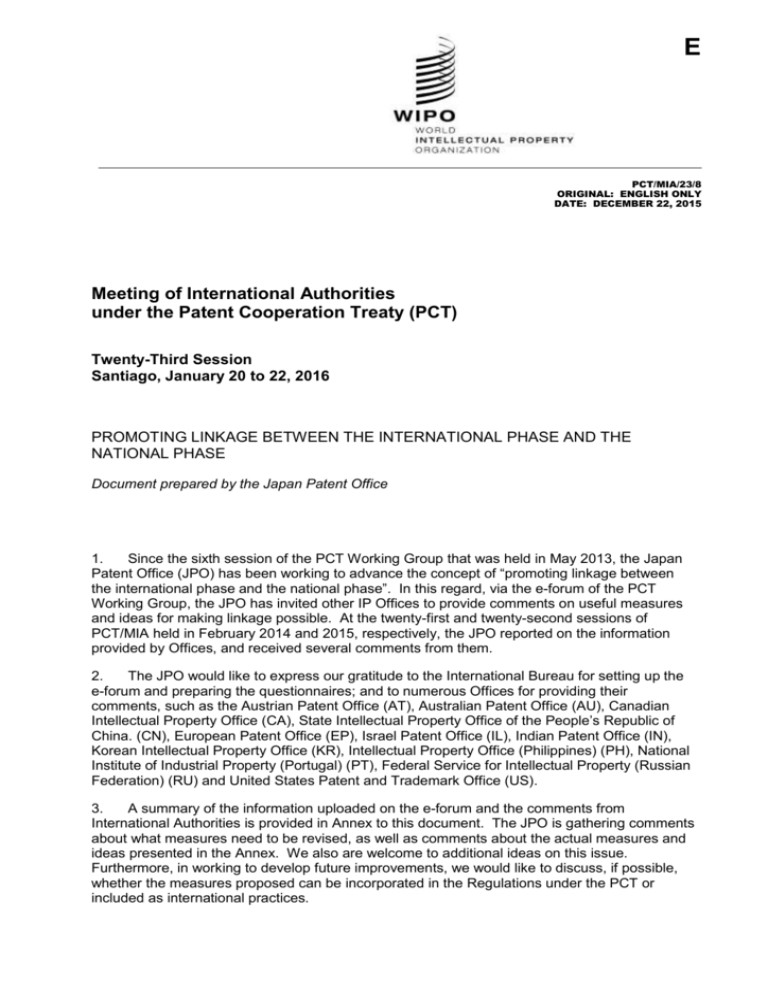
E PCT/MIA/23/8 ORIGINAL: ENGLISH ONLY DATE: DECEMBER 22, 2015 Meeting of International Authorities under the Patent Cooperation Treaty (PCT) Twenty-Third Session Santiago, January 20 to 22, 2016 PROMOTING LINKAGE BETWEEN THE INTERNATIONAL PHASE AND THE NATIONAL PHASE Document prepared by the Japan Patent Office 1. Since the sixth session of the PCT Working Group that was held in May 2013, the Japan Patent Office (JPO) has been working to advance the concept of “promoting linkage between the international phase and the national phase”. In this regard, via the e-forum of the PCT Working Group, the JPO has invited other IP Offices to provide comments on useful measures and ideas for making linkage possible. At the twenty-first and twenty-second sessions of PCT/MIA held in February 2014 and 2015, respectively, the JPO reported on the information provided by Offices, and received several comments from them. 2. The JPO would like to express our gratitude to the International Bureau for setting up the e-forum and preparing the questionnaires; and to numerous Offices for providing their comments, such as the Austrian Patent Office (AT), Australian Patent Office (AU), Canadian Intellectual Property Office (CA), State Intellectual Property Office of the People’s Republic of China. (CN), European Patent Office (EP), Israel Patent Office (IL), Indian Patent Office (IN), Korean Intellectual Property Office (KR), Intellectual Property Office (Philippines) (PH), National Institute of Industrial Property (Portugal) (PT), Federal Service for Intellectual Property (Russian Federation) (RU) and United States Patent and Trademark Office (US). 3. A summary of the information uploaded on the e-forum and the comments from International Authorities is provided in Annex to this document. The JPO is gathering comments about what measures need to be revised, as well as comments about the actual measures and ideas presented in the Annex. We also are welcome to additional ideas on this issue. Furthermore, in working to develop future improvements, we would like to discuss, if possible, whether the measures proposed can be incorporated in the Regulations under the PCT or included as international practices. PCT/MIA/23/8 page 2 4. At the twenty-second session of the PCT/MIA, several Authorities expressed concerns that discretion should be given to their national laws, when considering measures that deal with national phase procedures. At the Meeting, the JPO would like to discuss the direction that should be taken in advancing linkage between the international and national phases, taking into consideration any specific concerns. 5. With a view to achieving further progress at this session, the JPO would be grateful if Offices wishing to make comments or voice their opinions on this matter could post them on the e-forum at their earliest convenience. The JPO would like to continue this discussion, taking into account any additional input uploaded on the e-forum. 6. The Meeting is invited to comment on whether any of the measures and ideas referred to in the Annex to this document can be stipulated in the Regulations under the PCT or the PCT International Search and Preliminary Examination Guidelines. [Annex follows] PCT/MIA/23/8 ANNEX SUMMARIES OF COMMENTS AND PROPOSALS POSTED ON THE E-FORUM ISA MEASURES Existing practices (a-1) Taking into account earlier search (Rule 41): Each IP office has its unique rules. (i) Even if examination on the earlier application has not yet begun, searches are conducted before the ISR is established (JP). (ii) Amount of fees reimbursed: fixed amounts: (CA, IL, JP); amounts based on extent of usage: (RU). (iii) Amount of fees reimbursed is based on the subject-matter claimed: Fees are reimbursed when the subject matter is the same (EP); fees are reimbursed when unity exists among the claims of the earlier application and the IA (JP). Comments at PCT/MIA There is a need to clarify the method to specify the earlier application. There is no benefit to include this measure since hardly any applications would require it, since there are so few applications when the length of time from when they are filed to when the ISRs are established is short. We are against making this mandatory, since we are basically performing this same procedure already. Rule 41.1 should be broadly applied. (a-2) In citing patent documents written in languages other than English, indicate the corresponding part of the patent family documents written in English, if a patent family document in the English language exists (JP). Comments at PCT/MIA Although this may be beneficial, it creates more work. No need to make it mandatory. The patent family information by OPD is sufficient. At the twenty-second session, PCT/MIA agreed to advance the modification of the PCT International Search and Preliminary Examination Guidelines, in order that this measure (see paragraphs 26 and 27 of document PCT/MIA/22/22) be implemented based on the support by a number of Authorities. (a-3) Obtain search information from the office of earlier examination (EP); or from other ROs (AU). Comments at PCT/MIA Already implemented with regard to national applications. (a-4) Utilize international-type search results for provisional applications, before the complete PCT applications are filed (CA). (a-5) Provide the International Bureau and applicants search strategies, along with ISA & WOSA (IL). PCT/MIA/23/8 Annex, page 2 Proposals (b-1) Prepare WO/ISAs and such reports using expressions that can be easily translated into English. Comments at PCT/MIA Discussion about the Standard Clauses is sufficient. We cannot agree, since some information might be omitted as a result of simplifying descriptions. (b-2) Detailed and clear description of reasoning in WO/ISA (EP). (b-3) Clearly identify the scope of the search (in order to enable other IP offices to establish search strategies) (CA). Comments at PCT/MIA This proposal seems to closely relate to measure (a-5). (b-4) Conduct searches also on subject matter that is not considered patentable under one’s own national laws (CA, IL). Comments at PCT/MIA Not only applicants but also the Contracting States may benefit from this. Additional databases are needed to conduct searches on subject matter that is excluded from patentability under national laws. (b-5) Timely establish search reports of such quality that the ISA itself will fully rely on that search when the PCT application enters the national phase (IL). (b-6) Obtain search and classification information (KR) from other IP offices (RU). Note: New Rule 23bis.2 that will take effect from July 1, 2017 introduces “Transmittal of Documents Relating to Earlier Search or Classification for the Purposes of Rule 41.2”. NATIONAL OFFICE MEASURES Existing measures (c-1) Reduce fees for the national phase if Chapter II was carried out by the same office in the national phase (AU, EP). Comments in PCT/MIA We are already doing this (Same response by multiple IP offices). We have concerns/hesitations about adopting this measure. Fees are reduced at the national phase for applications determined to be patentable at the international phase. On the other hand, reducing fees based on Chapter II is inappropriate, since it would encourage users to utilize Chapter II for a different purpose from the original one. (c-2) Assign the same examiners to conduct both the national and international phase examinations, to the maximum extent possible (AU, EP, IL, JP). PCT/MIA/23/8 Annex, page 3 Comments in PCT/MIA We are already are doing this (Same response by multiple IP offices). We are against making this mandatory, since it is not always possible. If the same examiners do both phases, they will not conduct additional searches at the national phase, except for top-up searches. (c-3) The IP office carrying out the national phase examination limits national phase searches to documentation from specific countries such as one’s own country, or in languages such as one’s own, even when international phase work products by other IP offices are available (RU). Comments at PCT/MIA This is interesting, in terms of reducing duplicate work. Some examiners already do this at their own discretion. I have concerns about making rules on search methods, including the scope of additional searches. (c-4) Fees are reduced for applications when ISRs have been already issued. (CA, RU) The fees are further reduced if the ISR was issued by the same office as DO/EO (JP). (c-5) Publish search reports in one’s native language for all national phase applications, utilizing the International Search Report (AT). (c-6) Utilize PCT-PPH (CA, IL). Comments at PCT/MIA We support utilizing PCT-PPH (Same response by multiple IP offices) PCT-PPH is highly effective in encouraging applicants to overcome the reasons of refusals during the international phase prosecution. By increasing the number of offices participating in the PCT-PPH or by integrating the PPH and PCT systems, applicants will be encouraged to use Chapter II and amend claims as necessary at the international phase so as to make those claims patentable before entry into the national phase. Proposals (d-1) In view of the fact that the patent family information described in ISRs is not necessarily complete, create a system that adds to patent family information in documents cited in the ISRs, when the national phase is begun (JP). Comments at PCT/MIA This proposal would be quite useful. (d-2) Designated offices can require applicants to submit Chapter II reports in certain cases, such as when issues that have been pointed out in the international phase have not been resolved for all claims (BR). (d-3) Make it mandatory to respond to negative opinions presented in the international phase, when entering the national phase. Apply sanctions against any cases of non-response (UK/US joint proposal). Mandatory only if national and international phases are conducted by the same IP office (EP etc. PCT/WG/6/24 paragraphs 95 to 101). PCT/MIA/23/8 Annex, page 4 (d-4) Develop a feedback system from designated office to ISA/IPEA on how the prior art cited in ISRs are used in the national phase and the examination results in the national phase (JP, RU). Comments at PCT/MIA The proposal could create a burden on the DOs, and some IP offices cannot do this because of the their national laws. Examiner’s written opinion on the IPER would be sufficient. HOW WORK PRODUCTS IN THE INTERNATIONAL PHASE AND SEARCH RESULTS BY OTHER OFFICES ARE USED. Existing practices (e-1) Enable access to not only previous searches but also to prior examination reports and claim sets (CA). Comments at PCT/MIA Preferably IB should provide an IT system that enables offices to submit their search results along with relevant claims and examination results. We support this idea, whose direction is the same as that of the global dossier, OPD, WIPO-CASE. (e-2) Perform top up searches and expand classification for search subjects and like (AU). (e-3) Suggest to those, whose earlier applications have already been filed in other countries and been granted patent rights, to conform the claims to the allowed claims in order to obtain a direct allowance (PH). An applicant is entitled by law to request that an application be allowed on the basis of a foreign patent with claims identical to those granted in the foreign country (Israel Patent Law Section 17 (c)) (IL). (e-4) Provide automatic electronic access to documents cited by other offices for patent family applications (EP). (e-5) Provide tool for finding similar applications from the same applicant and the prior art cited in such applications (EP). (e-6) Examiners have to give due diligence to examination results by other IP offices, not just in the FA phase but throughout entire examination process, to ensure that foreign examination results considered are up to date (AU). (e-7) Review applicability or relevance of decisions on search result, novelty, invention, requirement of description, and like made by other offices in light of their own laws and regulations (AU). (e-8) Check the claims that were searched by the other office to see if the claims under examination are similar enough to rely on the results of earlier searches (AU). (e-9) Review a previous search in conjunction with the corresponding examination report to fully understand the previous search (CA). (e-10) In your own office, put to use information on appropriate classification and relative documents obtained from the results of other offices (PT). PCT/MIA/23/8 Annex, page 5 WAY OF PROVIDING SEARCH AND EXAMINATION INFORMATION Existing practices (f-1) Search information containing a full history of the International Search including a listing of databases consulted (including the IPC categories where relevant), the steps undertaken in the search, the specific terms keyed into the search engines, any chemical structures or gene sequences if relevant, the documents viewed, and the examiners who conducted the search (AU). (f-2) Electronically publish search strategy information (AU). Proposals (g-1) Require each IP office to submit search and examination results to WIPO, which will be the sole and central source of reference (e.g. WIPO-CASE) (AU, CA, IL). Comments at PCT/MIA Global Dossier is intended to be linked to WIPO-CASE, thus it may help in achieving the objective. (g-2) Indicate clearly the relevance of citations, novelty or inventive steps of claims, using category of documents or summary tables (AU). (g-3) Document sharing among offices, as well as sharing best practices, contributes to improving the quality of patents (PT). [End of Annex and of document]
